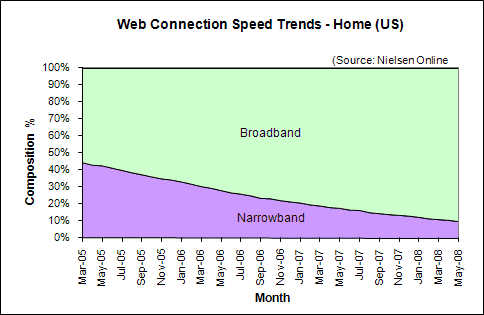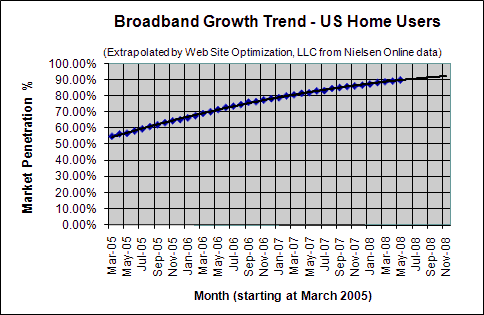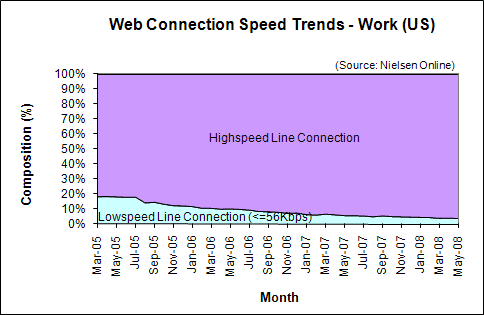Michael Copps of the FCC said that the US needs a “broadband czar” to coordinate how government agencies promote broadband. At a recent meeting in North Carolina to promote the state’s spread of broadband, speakers emphasized the need for a coordinated effort in the US in order to compete worldwide. Meanwhile in the US, broadband penetration approached 90% in May, only a rounding error away. Overall, US broadband penetration in less than 60% among US households, and is ranked 17th worldwide.
Study Calls for 1G Broadband in U.S. by 2015
The U.S. should aim for 100Mbps broadband available to all U.S. residents by 2012 and 1G bps by 2015 in order to catch up with other countries, according to a study released last Monday for a North Carolina conference. In the forum accompanying the report released by Baller Herbst, speakers emphasized the need to create a coordinate effort to deploy broadband access and boost broadband speed in the US. Michael Calabrese, director of the Wireless Future Program at the New America Foundation, said broadband is the “essential public infrastructure of the 21st century,” comparing broadband to electricity or telephony of the last century. Michael Copps, member of the U.S. Federal Communications Commission, said that the US needs a “broadband czar” who coordinates how government agencies promote broadband. The U.S. Department of Human and Urban Development should require broadband in all new public housing projects and schools and libraries should be encouraged to extend Internet access into the community with wireless networks.
Japanese Broadband versus the US
The US was 4th worldwide in broadband penetration in 2001, with Japan having only a handful of broadband lines. In 2008, after a coordinated effort to make broadband access universal, broadband in Japan is available to nearly every resident at speeds 10 times that of the US at about one-quarter the cost. The average broadband speed in the U.S. is 8.9M bps, slower than average speeds of 18 other OECD countries. Japan’s average download speed 93.7Mbps, more than 10 times faster.
Home Connectivity in the US
US broadband penetration grew to 89.96% in May 2008. Dial-up users connecting at 56Kbps or less now make up 10.04% of active Internet users, down 0.71 percentage points from 10.75% in April 2008 (see Figure 1).
Figure 1: Web Connection Speed Trends – Home Users (US)
Source: Nielsen Online
Broadband Growth Trends in the US
In May 2008, broadband penetration among active Internet users in US homes grew by 0.71 percentage points to 89.96%, up from 89.25% in April. This increase of 0.71 points is above the average increase in broadband of 0.56 points per month over the last six months (see Figure 2). As predicted broadband penetration will break 90% in June of 2008, at current growth rates.
Work Connectivity
As of May 2008, 95.95% of US workers connected to the Internet with broadband, up 0.31 percentage points from the 95.64% share in April. At work, 4.05% connect at 56Kbps or less (see Figure 3).
Figure 3: Web Connection Speed Trends – Work Users (US)
Source: Nielsen Online
Further Reading
- 90 percent of Ohioans have access to broadband, study says
- “More than 90 percent of Ohioan residents have access to high-speed broadband service, but only 55 percent subscribe to it, according to survey released today by Connect Ohio, a public-private partnership. The Columbus Dispatch, June 27, 2008.”
- Broadband Revolution: Developing a National Broadband Strategy to Keep the U.S. Prosperous in the 21st Century
- A report by the Baller Herbst Law Group for the e-NC Authority of North Carolina to promote the availability and adoption of broadband found that the U.S. needs a national broadband policy. In the accompanying forum to the report, Michael Copps of the FCC said that the US needs a broadband czar to oversee the spread of broadband in the United States. June 23, 2008.
- Jump-Starting our Tech Policy
- The US needs a broadband czar and an FCC dream team to kick start the spread of broadband in the United States, writes Tim Wu for Slate.com. April 1, 2008.
- Nielsen Online
- Provided the US broadband penetration data for active Internet users for the Bandwidth Report.
- Study Calls for 1G Broadband in US
- “The U.S. should aim for 100M bps (bits per second) of broadband available to all U.S. residents by 2012 and 1G bps by 2015 in order to catch up to other countries that are moving forward with broadband rollouts, recommends a study released Monday.” The US was 4th worldwide in broadband penetration in 2001, with Japan having only a handful of broadband lines. In 2008, after a coordinated effort to make broadband access universal, Japan is available to nearly every resident at speeds 10 times that of the US at about one-quarter the cost. The average broadband speed in the U.S. is 8.9M bps, slower than average speeds in 18 other OECD countries, according to the Organisation for Economic Cooperation and Development (OECD). Japan’s average download speed is more than 10 times faster, at 93.7M bps. PC World, June 23, 2008.



